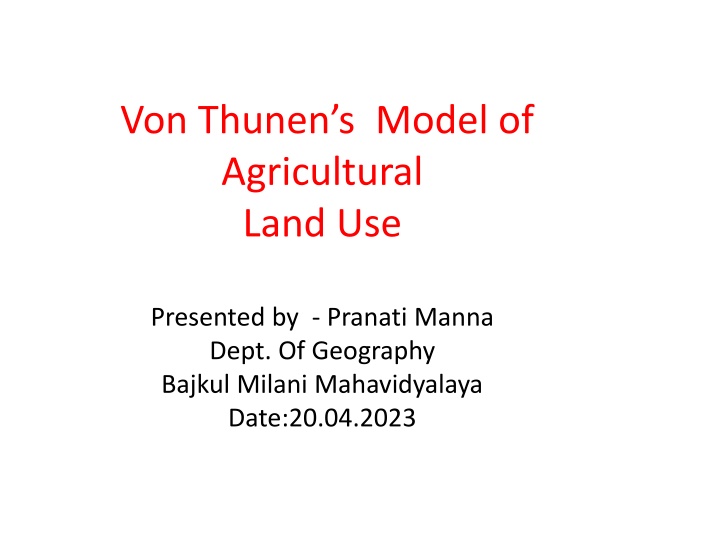
Von Thunen's Model of Agricultural Land Use
Explore Von Thunen's Model, a fundamental location theory in geography, illustrating how agricultural activities are organized based on distances from urban markets. The model's six key assumptions, concept of land rent, major concepts such as distance from the city and preservation of food, and practical applications to agricultural practices are discussed. Discover how different agricultural activities are strategically located based on market proximity and transportation considerations.
Download Presentation

Please find below an Image/Link to download the presentation.
The content on the website is provided AS IS for your information and personal use only. It may not be sold, licensed, or shared on other websites without obtaining consent from the author. If you encounter any issues during the download, it is possible that the publisher has removed the file from their server.
You are allowed to download the files provided on this website for personal or commercial use, subject to the condition that they are used lawfully. All files are the property of their respective owners.
The content on the website is provided AS IS for your information and personal use only. It may not be sold, licensed, or shared on other websites without obtaining consent from the author.
E N D
Presentation Transcript
Von Thunens Model of Agricultural Land Use Presented by - Pranati Manna Dept. Of Geography Bajkul Milani Mahavidyalaya Date:20.04.2023
Von Thunen Model: The first location theory A concentric model
Contains six assumptions 1. There is only one market available, self-sufficient with no outside influence. All farmers are market oriented, producing goods for sale. (Not subsistence.) The physical environment is uniform; there are no rivers or mountains. All points at equal distances from the market have equal access to the market. All farmers act to maximize profits. The dietary preferences of the population are those of Germanic Europeans. 2. 3. 4. 5. 6.
Land rent The main concept is land rent or land value, which will decrease as one gets farther away from central markets. Rent is highest in the closest proximity to urban markets. (Bid-Rent Theory) Thus, agricultural products that have intensive land use, have high transportation costs and were in great demand would be located close to urban markets.
Major concepts: Distance from the city Preservation of food Amount of space
So. 1. Dairying and gardening of fruits and vegetables would be closer to the urban market while Timber and firewood for fuel and building materials would be in the second zone. Mixed farming, commercial grain and orchards and Extensive cattle ranching would be located farther away. Transportation is cheap: the animals can walk to the city for butchering. 2. 3. 4.
Why? Some products spoiled more quickly, needed more sensitive transportation, or generate higher prices at market These products mean the farmer can afford higher land rent.
Inference of Von Thunens Model to Continental United States Forest Wheat Dairy Dairy Corn and Soybeans Vegetables Forest Vegetables Beef Cattle and Sheep Wheat Beef Cattle and Sheep Corn and Soybeans Specialty Crops Cotton and Tobacco Cotton and Tobacco Specialty Crops Assumptions 1. New York City the only market 2. Crops ranked by rent paying ability 3. No terrain variation 4. Climatic variation considered Assumptions 1. New York City the only market 2. Crops ranked by rent paying ability 3. No terrain or climatic variation B A
